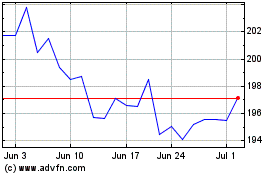By Alexander Osipovich
Futures trading has a reputation as a risky endeavor best left
for the pros. That's not stopping CME Group Inc. from encouraging
individual investors to try it out.
The Chicago-based exchange operator in November started airing a
television commercial showing a cheerful dad touting futures as he
strolls past a crude-oil pipeline and gold vault that have
materialized in his house. The message: At-home investors can use
futures and bet on different markets 24 hours a day.
The Commodity Futures Trading Commission, which regulates
futures, discourages individuals from trading them. On its website,
the CFTC describes trading futures as a "volatile, complex and
risky venture that is rarely suitable for individual investors or
'retail customers.'"
CME says its campaign is aimed at financially sophisticated,
well-funded individuals who are already active traders of stocks,
options or exchange-traded funds.
"We are not targeting the mom and pops on the street," Terry
Duffy, who is now chairman and chief executive officer at CME, said
on an Oct. 27 call with analysts.
CME said its markets are highly regulated and that its retail
campaign isn't hiding any risks. "Our main goal is to educate these
traders about our futures markets and ensure they are as informed
as possible about how they work," a CME spokesman said.
Trading futures can be attractive -- and perilous -- because it
allows heavy use of leverage, making large bets with a small amount
of money. Leverage can enable eye-popping profits if a bet proves
to be right but can also amplify losses. A trader stuck with a
losing bet could even be required to pay out more than he or she
put down initially.
In stock trades, retail investors are generally limited to
borrowing no more than 50% of the value of their stock portfolios,
a 2 to 1 leverage. By contrast, futures can offer leverage of 10 to
1, 20 to 1 or more, depending on which contract is being traded and
the requirements of the broker that a trader is using.
Futures markets are dominated by professional traders,
commodities firms and financial institutions. Retail makes up a
small slice of the pie, but it is growing. Between 5% and 10% of
CME's trading volume comes from retail customers, a percentage that
has roughly doubled since 2012, the spokesman said.
As the world's largest operator of futures exchanges, with a
market capitalization of more than $40 billion, CME regularly
enjoys profit margins in excess of 30%. Over the past decade, it
grew by acquiring rivals like the Chicago Board of Trade, New York
Mercantile Exchange and Kansas City Board of Trade.
Now, analysts and industry observers say, it faces the challenge
of finding new sources of growth, which makes the relatively
untapped retail segment attractive.
Daniel Skalak, 32 years old, said he left his job as a waiter
for the Manhattan restaurant Per Se in 2016 and moved to Georgia,
where he is now a full-time day trader focusing on E-mini S&P
500 futures.
"It really came down to the leverage," said Mr. Skalak on why he
switched from stocks to futures. On a good day, Mr. Skalak said he
can make $600 to $1,000. He pulls out of the market if his daily
losses approach $400, a policy he adopted after some steep
losses.
The futures market operates 24 hours, another reason interest in
futures has grown, brokers say. Last year futures volumes surged
during overnight trading frenzies on days like Nov. 9, following
President Donald Trump's election victory, or June 24, the night
after the U.K.'s vote to leave the European Union.
"In both cases, you had information coming in while the equities
markets were closed but the futures markets were open," said J.B.
Mackenzie, managing director of futures and forex at TD Ameritrade.
"What we saw was a tremendous engagement from retail traders during
that time."
The CME TV spot is accompanied by an online campaign, including
digital ad buys on financial media outlets, market-commentary
videos and websites on futures trading. The Wall Street Journal is
among the outlets where CME has bought ads.
When asked about the campaign, Sharon Bowen, a Democratic
commissioner on the U.S. Commodity Futures Trading Commission,
urged CME to warn retail investors of the dangers of futures
trading.
"It is my expectation that CME will provide special oversight to
small retail investors to ensure that they have a full
understanding of the risks involved in trading before they become
active in the futures market," Ms. Bowen said in a statement
emailed to the Journal.
CME collects fees when its contracts are traded. Analysts
estimate it made $3 billion from such trading-related fees in 2016,
accounting for 84% of total revenue, FactSet data show.
The company sees retail as "far from the only" potential growth
area, the CME spokesman said. Others include persuading more
corporations to hedge risk with futures and expanding
internationally, he added.
CME has run TV commercials before, including a 2013 ad featuring
billionaire entrepreneur Richard Branson. But longtime observers
say CME's latest campaign is the highest-profile effort yet to
encourage trading by active day traders.
"I haven't seen anything like it before coming from a futures
exchange," said Craig Pirrong, a finance professor at the
University of Houston who studies commodities trading. He said of
CME, "in order to eke out some additional growth, they have to find
potential customers, and retail is apparently one of the areas that
they've identified."
(END) Dow Jones Newswires
January 30, 2017 05:44 ET (10:44 GMT)
Copyright (c) 2017 Dow Jones & Company, Inc.
CME (NASDAQ:CME)
Historical Stock Chart
From Mar 2024 to Apr 2024

CME (NASDAQ:CME)
Historical Stock Chart
From Apr 2023 to Apr 2024
